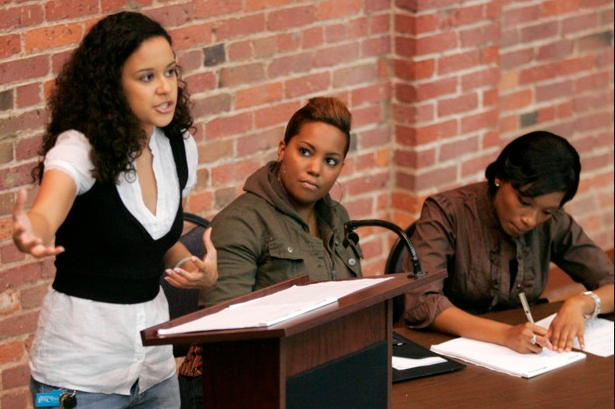When students participate in classroom discussion, they learn more than when they just listen. Students should leave any college having learned the ability to not only write well, but also to speak well in front of their peers.
But how do we get students to participate?

In larger sized classes, the sheer number of students generates a free-rider problem, where each individual student can assume that someone else will do the talking and they will not be called out. There must be an inverse relationship between the number of students and the rate of participation. If you don’t even know all their names, it will be difficult to grade participation. You’ve likely had classes where there is rich participation, but it is only a handful of students who do all the talking. You’ve also likely had classes where you feel like you’re are pulling teeth trying generate participation. What to do?
If you have a very large, lecture-hall-filled kind of class, it may seem like an impossible task that you wrote off long ago. The most innovative way I have seen this handled was when I was a TA for Professor Melissa Wilde, then at IU, now at UPenn. She taught an introduction to sociology course of about 400 students! On the first day of class she handed out 4-6 different colored index cards. Each student took 4 of the same colored card, wrote their name on them and then stored them away in their notebooks. Each day the class met, a different group of students, based on the color of the index cards, was given the opportunity to participate. When a student did, they would hand in their card with their name on it to be recorded as part of the course grade. Now, this required Professor Wilde to navigate the lecture hall with a microphone like a talk show, but that kept things lively and the student engaged. Of course, this is not the depth of discussion that you would hope for in a class of 20, but we shouldn’t ignore opportunities to generate even a little engagement.
Even in small classes, without some sort of accountability, it can be hard to get all but the most confident extroverted students to participate. Over the years, I have come to realize that, in many ways, students are like faculty: they have too many demands on their time and subsequently are going to focus on fulfilling the tasks that those above them have deemed important. As faculty, we signal to students what we believe to be important by the portion of the course grade we assign. Without being held accountable by a grade, students will turn their attention to another task, possibly in another class that is making more graded demands of them.

Using grading as a more immediate feedback tool
When I first started awarding points for participation, I had just one grade that was awarded at the end of the semester. This was quickly abandoned because of the flurry of shallow efforts to participate at the end of the semester. I then switched to awarding grades three different times evenly spaced throughout the semester. Each of the three sections is graded independently in order to reward consistency.
My most recent iteration is to continue with the three sections but at the beginning of each one, everyone is awarded a zero and must earn their way up.
This way they do not think they will get a C (or even 50%) just for being present. At the end of every couple weeks or so, I update their grade in an online grade book they have access to as an indicator of where they stand. This allows them to alter their level and depth of participation until the grades are finalized on the posted date. This serves as a signal to them of my expectations for a less quantifiable expectation.
This has resulted in increased student understanding of my expectations, a more reflexive awareness of their contribution, and higher rates of participation. It has not resulted in full participation. Some students are more than happy to ride out that zero, despite office hour suggestions of how they participate more/at all.
Even within this structure, I think it remains important to be a creative facilitator. A lesson I learned from one of my teaching mentors, Professor Brian Powell at IU, was to ask, “What questions do you have?” This sets the expectation that there are questions and it is perfectly normal as a student to ask them. Additionally, the most basic exercise to let students who are more reflective have time to think is to give the class the question(s), ask them to take a minute or two and jot down notes, and then call on people. You can also give the class a minute to talk to their neighbor before asking someone to speak alone before their peers. This gives students who are nervous a dry run to compose their thoughts and gain more confidence.
You can also provide students with the discussion questions as a prelude to the next class. That way, as they do the reading, they can write reflective notes that might facilitate their participation in the next class. See my previous post for critical thinking questions that will help prompt participation.
Teach well, it matters.

Comments 4
Dr. Ronald Beer — April 11, 2017
Very creative Dr. Beer. I concur wholeheartedly that more and better learning occurs when students are engaged is such a manner. Some just need to be coaxed or encouraged.
wifikill apk download — April 28, 2017
That is a really good tip particularly to those fresh to the blogosphere.
Brief but very precise information… Thanks for sharing this one.
A must read post!
Gail Brown — October 2, 2018
Thank you for sharing this, Dr. Beer (LOVE THE NAME...as I'm sure your students get a kick out of it, too).
I've been struggling with "that" class - you know, the class with the boring personality. I don't do anything different - same content, same style as other sections - but "that" class simply won't participate, willingly. I'm excited to try this.
damacai 4d — April 17, 2023
A great post without any doubt.